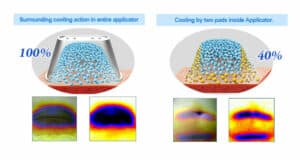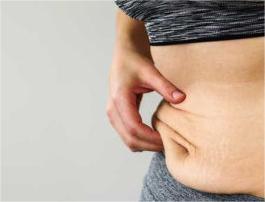Cellulite, a prevalent skin condition affecting over 90% of women, often arises from factors like childbirth, weight loss, poor diet, lack of physical activity, and surgery. It causes the appearance of dimpled, “orange peel” skin, typically in areas like the thighs, upper arms, hips, buttocks, and abdomen. While not harmful, many seek ways to diminish cellulite’s appearance for cosmetic reasons. Recent research has explored using acoustic sound wave therapy as a promising treatment for cellulite.
Acoustic wave therapy (AWT) employs high-frequency sound waves to transmit powerful mechanical forces deep into tissues, facilitating the breakdown of fibrous bands under the skin, promoting blood circulation, releasing growth factors that stimulate collagen production, and fortifying connective tissue. Through multiple focused sessions, AWT aims to enhance skin structure and elasticity, diminishing the characteristic bumpy appearance associated with cellulite.
This article delves into the scientific principles underpinning the use of acoustic waves in cellulite treatment. We will explore clinical findings from studies showcasing the effectiveness of AWT, draw comparisons between AWT and other cellulite treatments, discuss optimal treatment protocols, consider combined treatment approaches, and address post-AWT considerations.
What is Acoustic Wave Therapy
Acoustic wave therapy (AWT), sometimes known as extracorporeal shockwave therapy (ESWT), has recently emerged as a promising new treatment option for the improvement of cellulite. Here are critical points about acoustic wave therapy:
- Uses high-frequency acoustic waves or shockwaves to stimulate tissue and trigger natural healing processes
- The two main types used in cellulite treatment are:
- Focused shock waves: Penetrate up to 8cm deep into thigh tissue
- Radial shock waves: Disperse across wider, superficial areas
- Non-invasive, no surgery or needles, applied externally through applicator devices
- Works by boosting blood circulation, oxygen, and growth factors; reducing inflammation, and “unsticking” tissue adhesion
- Often used to treat hard kidney stones, hard bone tissues, and soft fat tissues
How Acoustic Wave Therapy Works on Cellulite
Acoustic wave therapy utilizes high-energy sound waves to improve cellulite through several physiological mechanisms:
1. Break down fibrous septae under the skin
- Focused acoustic waves physically disrupt fibrous septae – the taut bands under the skin that cause a dimpled look
- Allows fat cells to redistribute for a smoother appearance
2. Redistributing Fat Lobules
- Waves help “unstick” subcutaneous fat lobules
- Allows fat to realign under the skin more evenly
3. Improving Blood Circulation and Lymphatic Drainage
- Boosts microcirculation to cellulite areas
- Vasodilation improves local blood flow
- Enhances fluid drainage through the lymphatic system
4. Stimulating Collagen Production
- Stimulates fibroblasts to increase the production of collagen and elastin.
- Neocollagenesis thickens and tightens skin
This combination of tissue and cellular effects smoothes out depressions, dimples, and irregularities caused by cellulite at different skin depths for visible improvements.
Efficacy of Acoustic Wave Therapy for Cellulite
Ongoing research explores AWT’s effects on cellulite, with outcomes differing among individuals. Key improvements shown in trials include:
- Visible smoothing of the skin with fewer dimples and contour irregularities
- Increasing dermal thickness and improving skin elasticity
- Enhancing the release of growth factors to stimulate neocollagenesis
Here are some clinical results from scientific studies:
- A study on 30 women undergoing 12 AWT treatment sessions showed reduced cellulite severity scores for up to 12 weeks post-treatment. Assessments were conducted at the baseline and up to 12 weeks post-treatment, encompassing the Cellulite Severity Scale (CSS), body circumference measurements, and subcutaneous fat thickness using magnetic resonance imaging (MRI). The Cellulite Severity Scale (CSS):
- Scores cellulite from 0-15 based on 5 criteria like depth of depressions
- Mild: 1-5
- Moderate: 6-10
- Severe: 11-15.
- Multiple studies using subjective physician and patient assessments, standardized photography, and 3D imaging have shown visible improvement in the appearance of cellulite and a reduction in both thigh circumference and subcutaneous fat layer.

In summary, acoustic wave therapy (AWT) has proven effective in tackling cellulite, providing a non-invasive alternative to surgical interventions. Research indicates a reduction in cellulite severity from baseline, visible improvements on the skin’s surface, and the absence of severe side effects associated with AWT. The required number of sessions for noticeable results varies based on individual factors and the extent of cellulite. While early findings are encouraging regarding AWT’s efficacy in cellulite treatment, more extensive, long-term studies are necessary to convincingly establish the durability of these effects.
Comparison to Other Cellulite Treatments
While Laser treatment and Subcision are frequently employed for cellulite treatment, acoustic wave therapy emerges as a superior non-invasive solution, offering unique advantages over these traditional methods.
Advantages Over Lasers
- Acoustic wave therapy shows better short-term improvements in skin smoothing and dimple/cellulite reduction than lasers.
- The effects of acoustic wave therapy last longer than laser treatments – over 6 months in some studies, while laser effects may dissipate faster over time.
- Multiple repeat treatments of acoustic wave therapy can be performed for cumulative, longer-lasting improvements in cellulite. Repeated laser treatments may be limited due to downtime and side effects.
- Acoustic waves boost collagen production, enhancing skin tightening and thickening more than lasers.
Advantages Over Subcision
- Acoustic wave therapy is non-invasive and does not require surgery or downtime as Subcision does. Subcision involves making small incisions to cut fibrous bands under the skin, requiring several weeks of recovery.
- Acoustic waves improve multiple aspects of cellulite, including skin texture, dimpling, and contour irregularities. Subcision mainly releases fibrous septae bands under the skin.
- Multiple treatments of Acoustic wave therapy can be performed for cumulative improvements. Repeated Subcision procedures are more difficult due to the surgical nature of the technique.
- Acoustic wave therapy is safe and well-tolerated with a low side effect profile of temporary redness or bruising, if any. Subcision has risks of bleeding, infection, and scarring.
Treatment Protocol
A typical acoustic wave therapy protocol for cellulite consists of:
- 5-7 treatment sessions spaced 3-4 weeks apart
- Sessions last 30-60 minutes, depending on the area treated
- Use of focused shock waves that target depths up to 8cm, or radial shock waves that treat wider superficial zones
- 2000-4000 acoustic wave pulses per treatment
- 0.25-0.35 mJ/mm2 energy flux density
- No anesthesia required
Optimal protocols are still being researched, but combining focused and radial acoustic wave treatment may be the best cellulite reduction method by treating both deep and superficial tissue structures.
Combination Therapies
Acoustic wave therapy can be effectively combined with other cellulite treatments like:
- Laser treatment
- The combination of laser and AWT can provide enhanced skin tightening and smoothing effects compared to either treatment alone.
- Lasers and AWT work through different mechanisms – lasers remodel the collagen and improve skin structure, while AWT breaks up fibrous septae and boosts circulation.
- Radiofrequency (RF)
- Combining modalities with different mechanisms of action may have synergistic effects. RF delivers thermal energy to tissue, which can stimulate collagen remodeling. AWT uses mechanical pressure waves to break up fibrous septae.
- The study examined the effectiveness of a unique combination involving extracorporeal shock wave therapy (ESWT) and a system inducing apoptosis through radiofrequency (AiRF) for the purpose of circumferential reduction. In both the 4-week and 6-week treated groups, all patients exhibited statistically significant reductions in waist circumference.
Considerations After AWT for Cellulite
- Tenderness, bruising, or redness may occur after the treatment which typically resolves within a few days.
- Multiple, consecutive AWT sessions about 1 week apart are needed for optimal cellulite improvements, so follow the recommended treatment plan.
- Maintain adequate hydration and adopt a nutritious diet to support and sustain improvements in cellulite.
- Consider additional skin care like massages or topicals to boost circulation and drainage between AWT sessions.
- Results tend to improve progressively for weeks after the initial treatments. Follow maintenance sessions every 2-3 months.
In summary, allow the body to rest initially, attend all recommended follow-up AWT appointments, and incorporate healthy lifestyle habits to help maximize and maintain the cellulite improvements from acoustic wave therapy over time.






